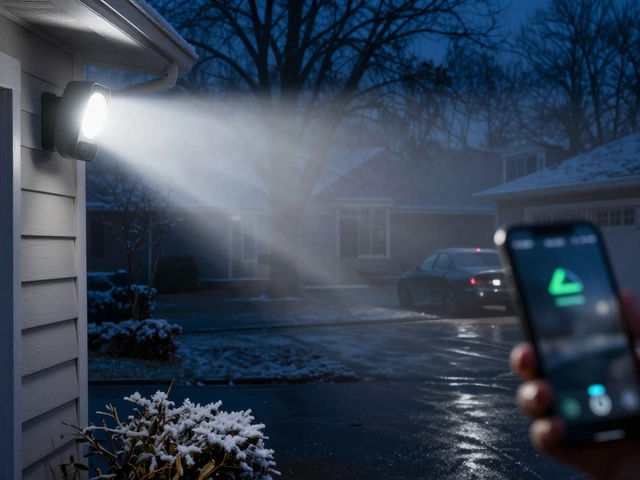Feeling safe at home isn’t just about locking your doors. The kind of burglar alarm you install can make or break your whole security setup. Sure, all alarms claim to protect you—but in the real world, not every system stops burglars or scares them off fast enough. So what separates a decent alarm from one that actually works when it counts?
If you’ve ever compared alarm systems, you know how confusing the choices can get. Some rely on loud sirens, others alert your phone, and a few even call the cops on their own. But the trick is knowing which features actually slow down or stop a thief—and which ones just make noise after the fact. In this article, you’ll find out which alarm types are truly effective and why.
- Not All Alarms Are Created Equal
- Wired vs. Wireless: The Real Difference
- Smart Alarms: Hype or Game-Changer?
- Choosing the Right Alarm for Your Space
Not All Alarms Are Created Equal
If you think all alarm systems do the same job, think again. The truth is, most break-ins happen fast—often in under eight minutes. This means the best burglar alarm is the one that reacts quickly and gets the thief out, not the one that just makes noise after your stuff's already gone.
There are tons of alarm types. Some just blare a siren, some send alerts to your phone, and the smarter ones can even patch straight through to emergency services. But the level of protection varies a lot. Here’s what researchers and insurance companies have found is most important:
- Response time: Systems that notify you (and the authorities) within seconds are way more effective than those that just make a loud sound.
- Visibility: Thieves usually avoid houses with visible alarms and window stickers, so a big, obvious system actually keeps you safer.
- Layered sensors: Good systems use door and window contacts, motion detectors, and sometimes glass-break sensors to cover all the usual break-in spots.
- Connection type: Wireless systems are harder to disarm, but older, wired alarms can be busted easily if someone cuts the lines.
- Notifications: Real-time phone alerts or monitoring services let you act immediately, even if you’re not home.
Let’s look at some numbers. According to a security industry report in 2023, homes without any alarm system are 300% more likely to be broken into. Households with clearly visible alarm systems saw a 60% drop in attempted break-ins. Here’s what the data looks like:
| Alarm Type | Average Police Response (min) | Burglary Success Drop (%) |
|---|---|---|
| Traditional Siren Only | 10+ | 15 |
| Monitored (24/7 service) | 4 | 60 |
| Smart Alarm (real-time app alert) | 2-4 | 55 |
If you want real protection, you can't just stick any alarm on your wall and hope for the best. Choose one that’s hard to bypass, gives you fast warnings, and gets the right people involved straight away. The next sections will break down what makes these systems tick—and how to pick the best one for your needs.
Wired vs. Wireless: The Real Difference
This is the big showdown in the burglar alarm world: old-school wired systems versus modern wireless setups. Each has real pros and cons, and what works best depends on your space and lifestyle.
Wired alarms are what most folks think of when they picture tough home security. They run cables through your walls, and everything connects right back to a central control panel. These are reliable—no batteries to check and almost zero chance of signals getting jammed. There’s a reason banks and some businesses still go wired. But if you want one for your home, get ready for a more involved (often messy) installation, especially if your place wasn’t pre-wired during construction. Think drilling, dust, and possibly some paint touchups afterward.
Wireless alarm systems have changed the game. You skip the wires—most sensors stick onto doors and windows, and they send instant alerts to a hub using radio frequencies or even your WiFi. You can install them yourself in under an hour, move sensors around, and expand easily. And here’s what a lot of people love: these systems often play nice with your phone, meaning you’ll get alerts or can disarm right from your pocket, even if you’re out grabbing groceries.
So, what about the downside? Wireless alarms run on batteries, so you need to check those about once a year (sometimes more, depending on the brand). And though rare, really thick walls or lots of metal can mess with the signal, but that only pops up in unusual cases like certain basements or older buildings with strange construction.
Quick overview to help you compare:
| Feature | Wired | Wireless |
|---|---|---|
| Installation | Professional, invasive | DIY-friendly, simple |
| Reliability | High, not affected by wireless jamming | Very good, but rare interference possible |
| Maintenance | Low (no batteries) | Must check/replace batteries |
| Flexibility | Hard to move or expand | Easy to adjust or add |
| Smart Home Compatibility | Often limited, unless upgraded | Usually excellent (app controls, automation) |
If budget is tight or you rent your home, wireless is probably the way to go. But if you’re building a new house or want heavy-duty security that you never think about again, a wired system still has an edge. Both options can call the cops or send phone warnings, so pick based on your needs—not just the latest trend.

Smart Alarms: Hype or Game-Changer?
Smart alarms have exploded in popularity, mostly because they let you control them straight from your phone. But are they actually better at stopping break-ins, or do they just add fancy features? Let’s look at what you actually get when you go "smart."
First off, smart alarms combine traditional sensors with tech like Wi-Fi or cellular alerts. The biggest win here is that you’ll get instant notifications wherever you are—not just if you’re sitting at home when the siren goes off. Some systems even let you livestream your security cameras, so you can see what’s happening real-time the second a sensor trips.
Here’s why smart alarms win out for a lot of people:
- You don’t need a professional to install most systems—they’re made for DIY setups.
- You get automatic updates and new features through software, so you don’t have to replace anything to stay current.
- Linking smoke, door, and motion detectors is simple, letting you customize alerts for different rooms or times of day.
- Many systems let you integrate smart locks, lights, or garage doors, so you control it all in one app.
Now, there’s a catch: all these perks mean you need a good internet connection, and some brands charge monthly fees for cloud services or 24/7 monitoring. Without monitoring, you might miss an alert if your phone is off or you’re somewhere without service. Still, the real-time response is a dealbreaker for most—according to a 2024 TechSecure survey, 68% of people with smart alarms said they reacted faster to break-ins just because of the phone notifications.
Let’s break down a few features side by side, so you can see where smart alarms shine compared to old-school models:
| Feature | Smart Alarm | Traditional Alarm |
|---|---|---|
| Remote Access | Yes, from app | No |
| Instant Mobile Alerts | Yes | No |
| Camera Integration | Easy with most systems | Rare |
| DIY Friendly | Usually | Often needs pro install |
| Updates/Upgrades | Software-based | Hardware swap needed |
It’s not all hype—smart alarms really raise the bar for what a burglar alarm can do. You just have to weigh the extra cost and make sure you’re cool with everything being connected. If you hate monthly fees or don’t want tech in every corner, old-school alarms can still work. But if you want quick alerts and total control from your pocket, smart is the way to go.
Choosing the Right Alarm for Your Space
The right burglar alarm depends a lot on your actual living situation and what you’re trying to protect. For example, a small apartment doesn’t need the same system as a big house with a garage and multiple entry points. Before you drop cash on anything, figure out your risk, your budget, and how hands-on you want to be. Some alarms just need an app, while others might demand drilling holes and wire work—or a professional to set up the whole thing.
If you’re a renter, wireless systems make way more sense. They’re easy to install, come down when you move, and won’t cost you your security deposit. Homeowners or small business owners might lean towards wired setups because they’re harder for a burglar to disable. Bigger properties with different zones (think garages, sheds, or upstairs windows) usually work best with a mix of motion sensors, door/window sensors, and glass-break detectors all tied together. And if you’re away a lot, smart alarms that alert your phone or even the police mean you don’t have to rely on neighbors hearing a siren.
Here’s a look at what features matter most for different types of places:
- Apartment/Small House: Go for wireless alarm kits with door/window sensors and a loud built-in siren. Smart systems with phone alerts add even more peace of mind.
- Large Home or Garage: Wired systems or hybrid models (wired backbone, wireless add-ons) are more reliable if you want full coverage. Layer in motion and glass-break sensors for better chances at catching someone fast.
- Business/Storefront: Systems with professional monitoring, panic buttons, and cameras can help reduce losses and make insurance claims easier to prove.
According to research from the FBI’s 2023 Crime Report, homes without a security system are about 300% more likely to get broken into compared to those with one. Burglars spend less than 60 seconds trying to get inside—if a burglar alarm triggers right away, most bail before grabbing anything.
| Alarm Type | Best For | Average Cost (USD) |
|---|---|---|
| Wireless DIY Kit | Apartment, renters | $100–$350 |
| Wired System | Homeowners, large homes | $600–$1500 (installed) |
| Monitored Smart Alarm | Frequent travelers, businesses | $200–$500 + $20/month |
| Basic Audible Alarm | Garage, sheds, budget backup | $25–$100 |
If you ever feel stuck or unsure, talk to your local police department—they often offer free security checks. And don’t forget to stick the alarm company signs in your yard or window; sometimes that basic warning is enough to make a burglar move on to the next target.






